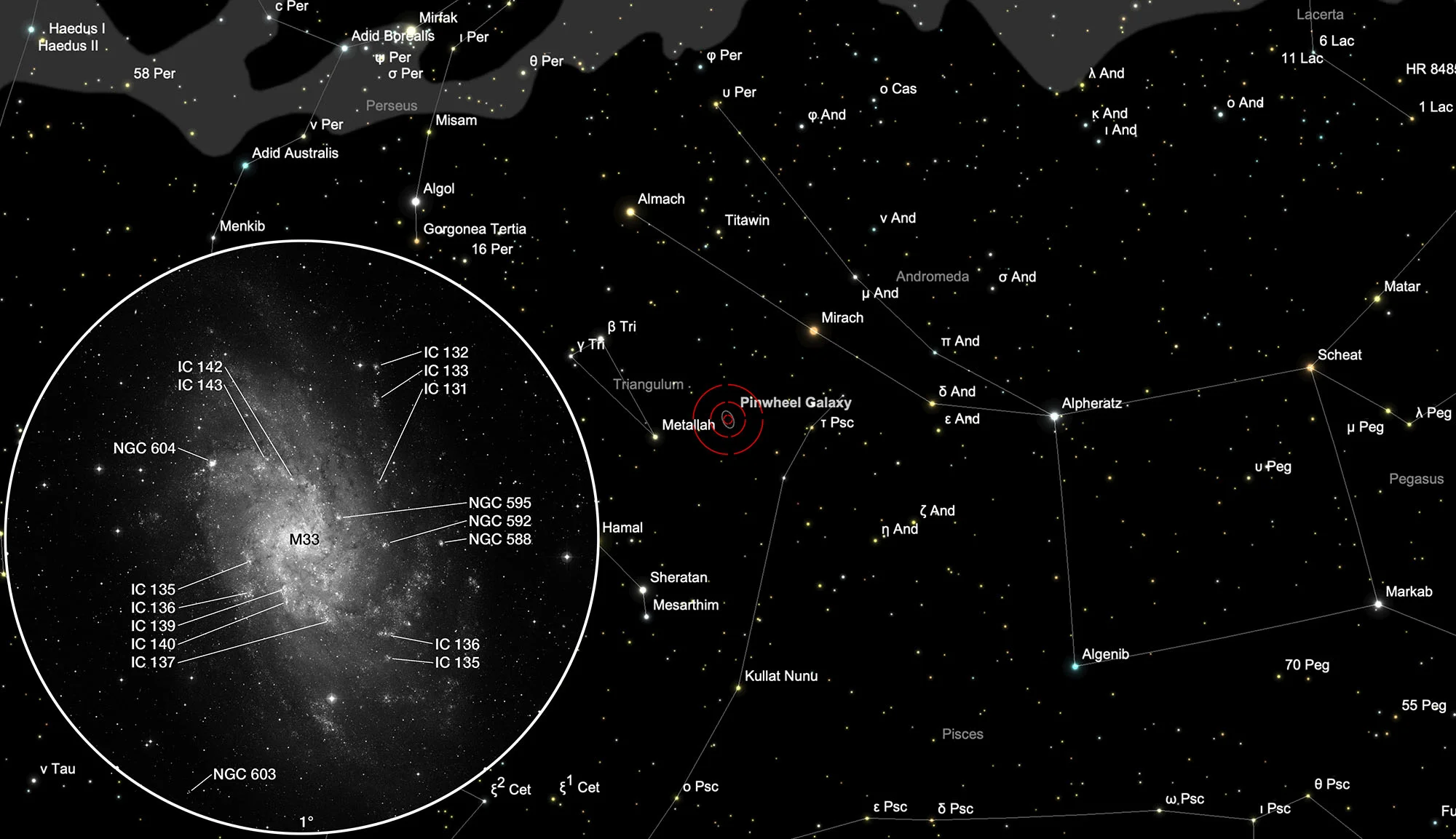Triangulum Galaxy (Messier 33)
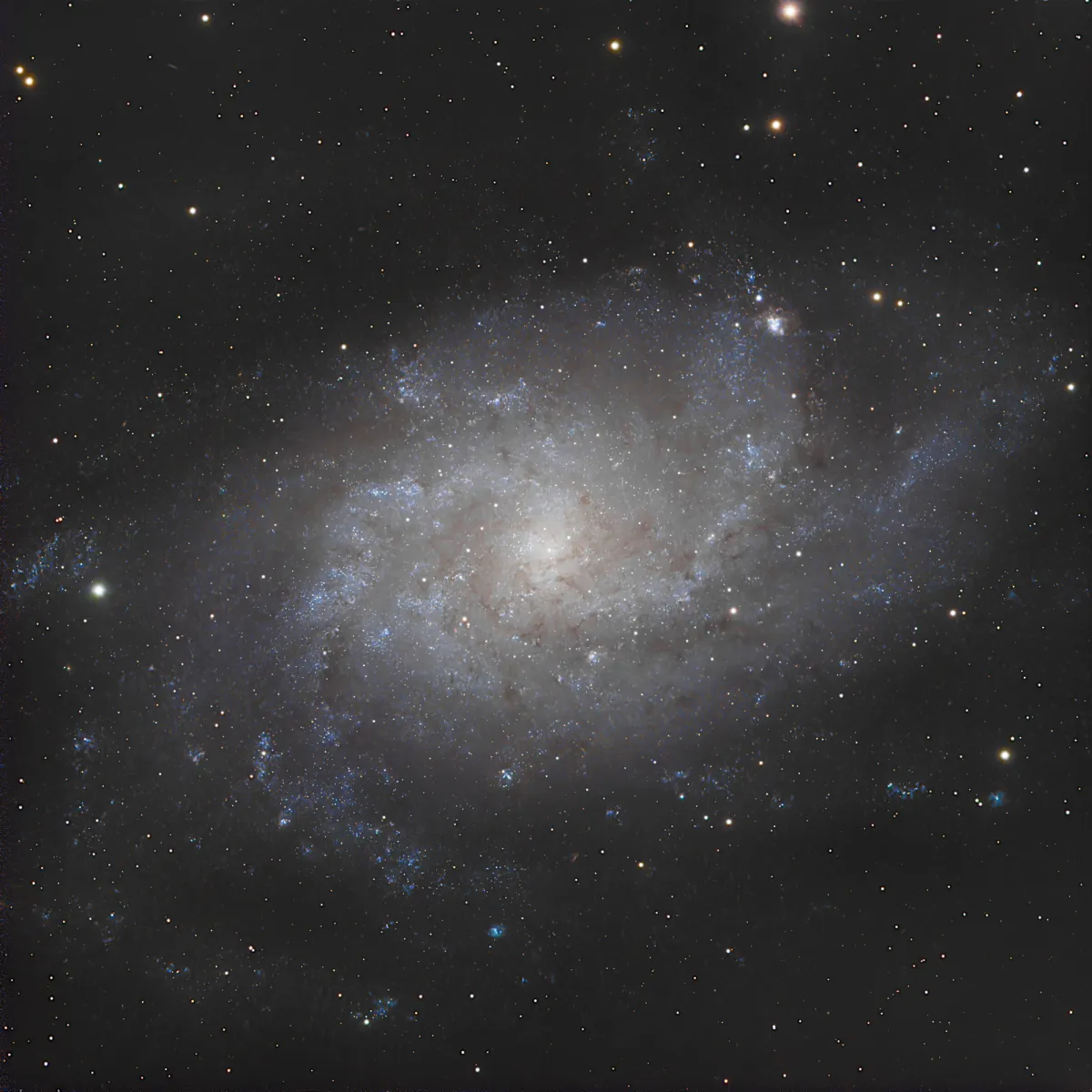
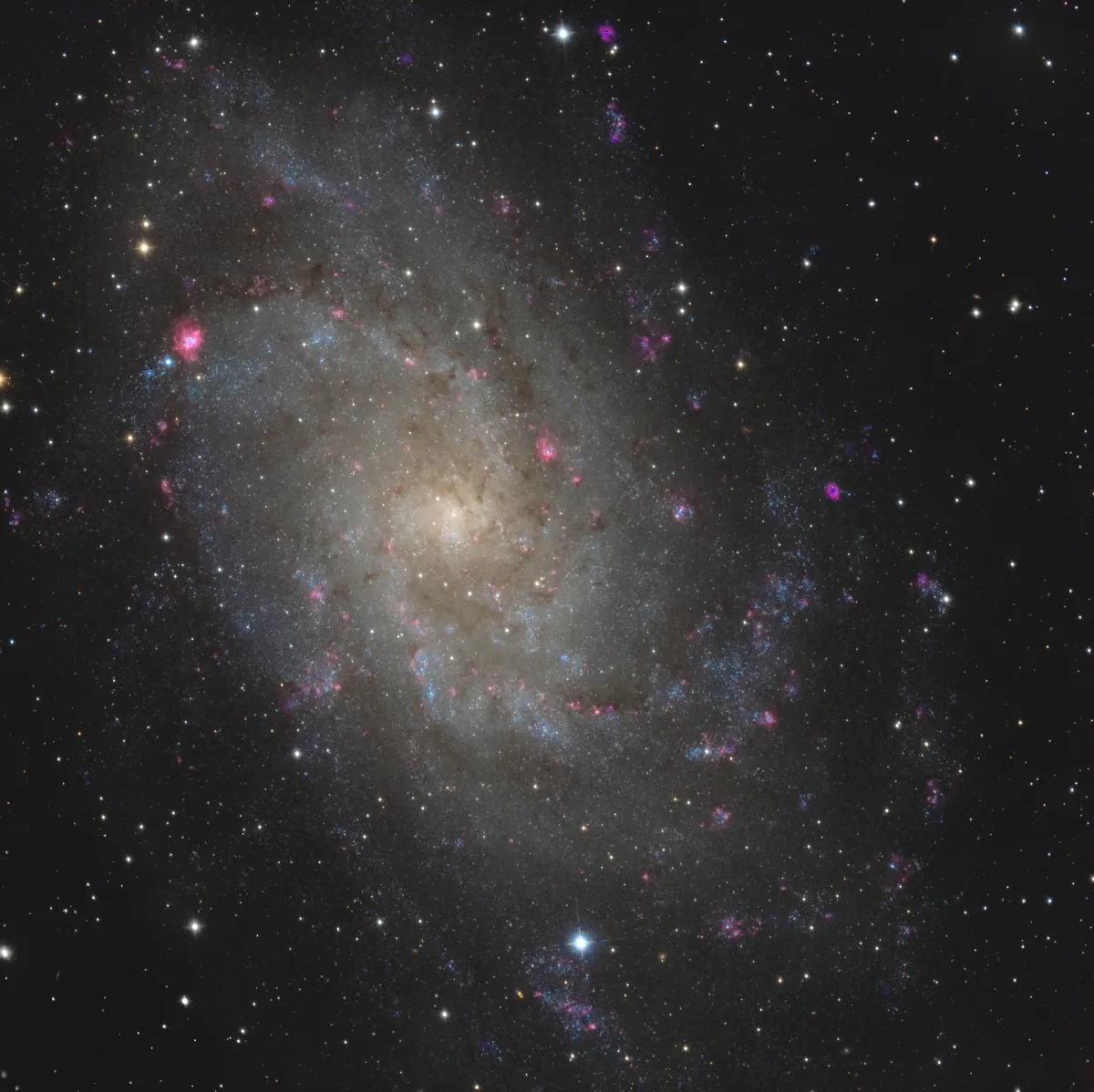

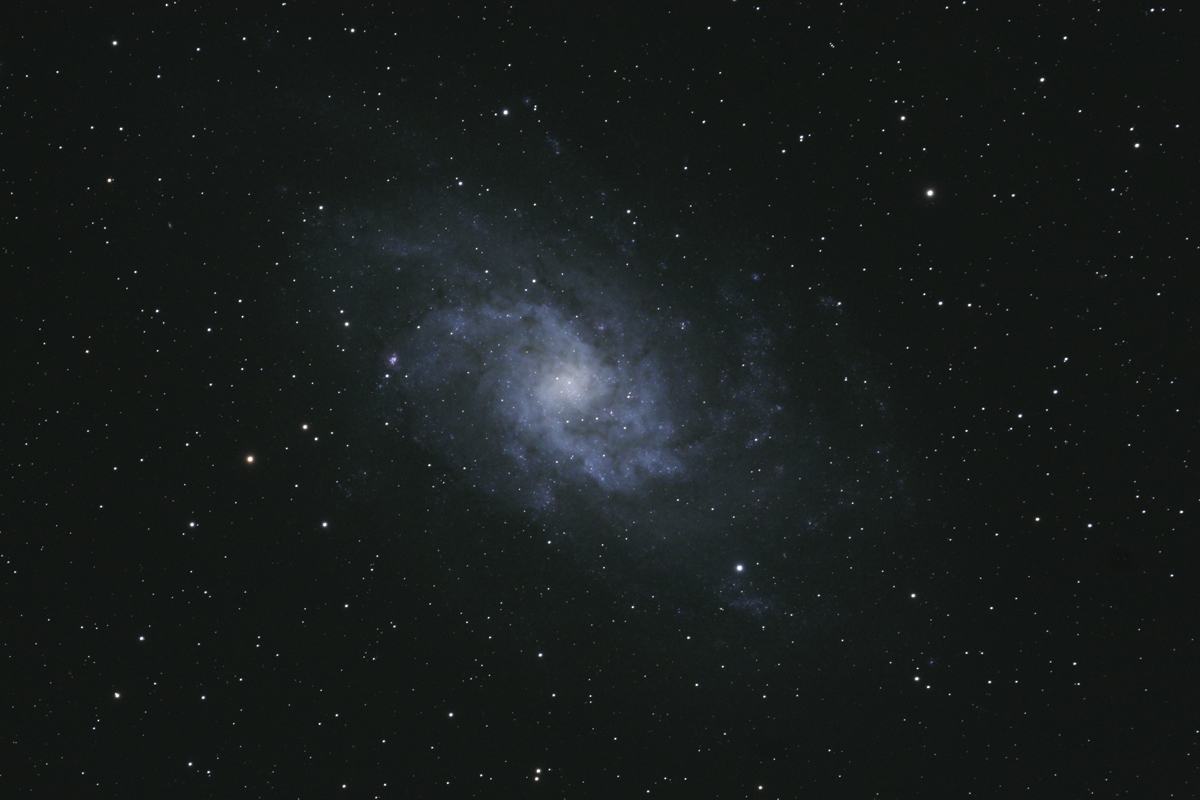

History
This galaxy was first sighted by the Italian astronomer Giovanni Battista Hodierna using a small refractor telescope in Palermo. At that time he discovered a large number of nebulae known today, but unfortunately his publication of 1654 received little attention outside of Sicily. [196, 277]
On 25 August 1764 Charles Messier observed the galaxy and listed it as 33rd object in his list. He wrote: «The nebula is of a whitish light, of almost equal density, however a little more luminous at two-thirds of its diameter, and contains no stars. It is difficult to see it with an ordinary telescope of one foot» [281]
William Herschel observed the nebula on 11 September 1784. He classified it as V 17 and described it as «milky nebulosity, not less than 1/2 degree broad. perhaps 3/4 degree long, but not determined.» He also noticed a small, faint nebula nearby which he cataloged it as III 150 and later became known as NGC 604. [464]
In 1850 Bindon Stoney was using the giant 6 foot aperture telescope «Leviathan» of his employer William Parsons, 3rd Earl of Rosse, and discovered a large spiral structure full of knots. [485, 486] The three brightest of the nodes were later assigned the numbers NGC 592, NGC 595, NGC 603 by Dreyer. In 1889 the French astronomer Guillaume Bigourdan found further knots with a 12.4 inch refractor telescope which have received the IC designations. [277]
Physical Properties
The best photographs show M 33 with an angular extent of about 67x41.5 arc minutes. The visual diameter is usually around half a degree. The integrated photographic brightness is 7.8 mag and the visual is 5.7 mag. The surface brightness of M 33 is very low. It is only 14.2 mag. This usually makes the M 33 a great disappointment when an amateur astronomer tries to view with his telescope for the first time. Many people aim their telescope at the specified position and then expect to see a large, bright galaxy like the Andromeda galaxy in the telescope or binoculars - but with the best will in the world, nothing like it can be found! Some even drive over M 33 several times without recognizing it and then believe that the galaxy is incorrectly marked on the map. No wonder, because M 33, with an angular extension of around one degree, is usually just as large or even larger than the field of view of a telescope and its low surface brightness makes it slightly brighter than the sky background of a mediocre night.
As the distance of M 33 one finds values of 2.4 to 3.6 million light years in the literature. Presumably it is close to 2.5 million light years. M 33 is moving towards us at a speed of around 200 km/s and at the same time away from the centre of the local group at 68 km/s. It is the closest spiral galaxy to the larger and less irregular Andromeda Galaxy M 31, but one of the most distant members of the Local Group. The galaxies M 31 and M 33 are only about 570'000 light years apart. After the Andromeda Galaxy and the Milky Way, M 33 is the third largest member of the Local Group.
With the large telescopes of the professional observatories it is easy to resolve this galaxy into single stars. It shows a huge double-armed spiral structure of star clouds, which circle around the bright core region. The arms are thick and lumpy, speckled with nebulous regions, and the spiral structure is loose and irregular when comparing M 33 with such symmetrical galaxies as M 81.
Allan Sandage points out in his Hubble Atlas of Galaxies that M 33 is the closest of the Sc spiral galaxies and that the stellar composition can be investigated down to stars of -1.5 mag absolute brightness. The first detailed study of the stars in M 33 was undertaken by Edwin Hubble in 1926. Among the known members we find bright O and B stars, open and globular clusters, Cepheids and irregular variables, Novae and bright nebulae. The spiral arms contain tons of blue supergiants, which is why the light from M 33 is bluer than that from other galaxies. The integrated spectral type is around A7 and the colour index is close to +0.2.
Including the finest extensions of the spiral arms, the galaxy measures around 60'000 light years in the longitudinal axis. According to a study by E. Holmberg, the mass of the visible stars in M 33 is about 8 billion solar masses and the total light is about 3 billion times brighter than the sun, or about -19 mag absolute. The galaxy rotates clockwise, so it drags its arms like a wheel of fire. The orbital period in the peripheral region was calculated to be 200 million years. [4, 75, 123]
| Designation | NGC 598 |
| Type | Gx (Sc) |
| Right Ascension (J2000.0) | 01h 33m 51.9s |
| Declination (J2000.0) | +30° 39' 29" |
| Diameter | 68.7 × 41.6 arcmin |
| Photographic (blue) magnitude | 6.3 mag |
| Visual magnitude | 5.7 mag |
| Surface brightness | 14.2 mag·arcmin-2 |
| Position Angle | 23° |
| Redshift (z) | -0.000597 |
| Metric Distance | 0.880 Mpc |
| Dreyer Description | ! eB, cL, R, vgbMN |
| Identification, Remarks | WH V 17; h 131; GC 352; M 33; UGC 1117; MCG 5-4-69; CGCG 502-110; Triangulum galaxy |
Deep-Sky Objects in M 33

Since the inclination of galaxy M 33 is not as strong as that of the Andromeda Galaxy (M 31), we are looking at the disk at an angle of 54 degrees. Thanks to its close proximity, M 33 offers a large number of extragalactic deep sky objects. About 80 emission nebulae were counted in the spiral arms. The brightest and most distinctive of them have own NGC numbers. The weaker and smaller are listed in the index catalog.
By far the most fascinating and largest deep sky object in M 33 is what we consider to be the brightest, extragalactic H-II region NGC 604. It is located about 12 arc minutes northeast of the core of the galaxy.
This gigantic nebula is comparable in type and emission spectrum to the Orion Nebula. On the HST false colour image, it also looks like it in terms of shape. With a diameter of around 1500 light years, NGC 604 is around 100 times larger than the Orion Nebula. This region is in a spiral arm of M 33 where new stars are born. Inside, the nebula contains over 200 hot stars of 15 solar masses each and some with 60 or more solar masses - mainly young O and B supergiant. They heat the gas to around 10'000 Kelvin and thus make it fluoresce. The luminosity of the nebula is about 10 million times that of the sun. The starlight also clearly shows the three-dimensional shape of the nebula, which was created by the stellar winds. The stars literally blow the glowing gas away from the interior of the nebula and thus form two expanding shells, which can be seen as 'holes' on the picture.
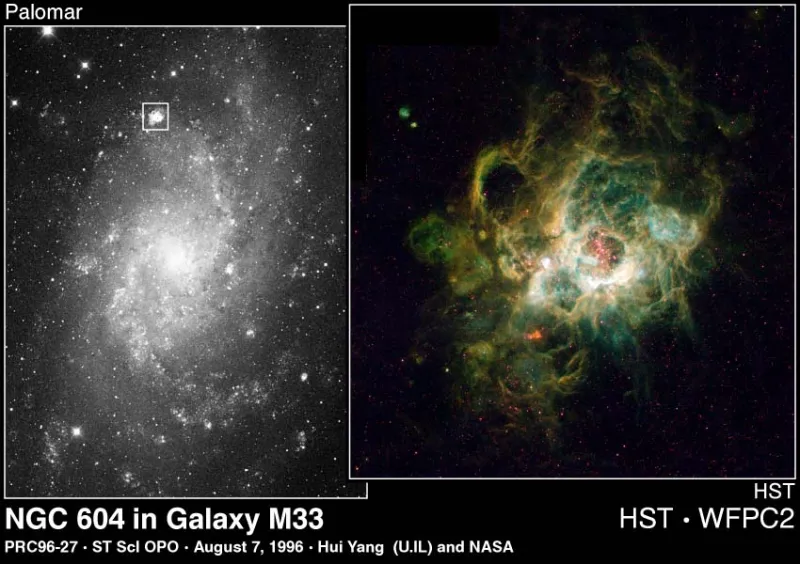
The false colour composite of NGC 604 from three images was created with the help of the Hubble Space Telescope in January 1995 by J. Jeff Hester of Arizona State University and his colleagues. On this picture, red represents the emission light from singly ionized sulfur, green from hydrogen and blue from doubly ionized oxygen. The red-orange object on the left below the centre of the image is the remnant of a supernova. [172]
The objects listed here are mostly beyond the limit of visibility that can be reached with amateur telescopes:
- NGC 603 is about half a degree south of the centre of the galaxy and was described by J. L. E. Dreyer as a faint nebula or cluster with three stars in it. In fact, there is no nebula and there are only three foreground stars. There are three non-stellar objects at this point in the GSC.
- Object IC 132 in the north-western part of the galaxy looks on the POSS image as if it were a planetary nebula, similar to the dumbbell nebula M 27 in our galaxy, but it would have to be much larger.
- IC 133 is four arc minutes south of IC 132 and shows a crescent-shaped, foggy shape. Presumably it is a similar object as the Cirrus Nebula.
- Other IC numbers that could be identified with structures on the POSS photo plates are IC 131, 135, 136, 137, 142 and 143. IC 134, 139 and 140 have no prominent emission nodes.
| Name | RA | Dec | Type | vMag | Dim | MD | Dreyer Description | Identification, Remarks |
|---|---|---|---|---|---|---|---|---|
| NGC 588 | 01 32 45.7 | +30 38 56 | GxyP | 13.5 | 0.65 | 0.880 | F, p of 2 | GC 348; HII+SCL in M 33 |
| NGC 592 | 01 33 12.0 | +30 38 47 | GxyP | 13.0 | 0.7 | 0.880 | F, pL, f of 2 | GC 349; HII+SCL in M 33 |
| NGC 595 | 01 33 34.0 | +30 41 32 | GxyP | 13.5 | 0.5 | 0.880 | vF, S, R, inv in M 33 | GC 5186; HII in M 33 |
| NGC 603 | 01 34 44.2 | +30 13 57 | *3 | S neb or Cl with 3 st inv | GC 357 | |||
| NGC 604 | 01 34 32.6 | +30 47 04 | GxyP | 12.0 | 1.95 | 0.880 | B, vS, R, vvlbM | WH III 150; h 133; GC 355; HII in M 33 |
| IC 131 | 01 33 11.1 | +30 45 10 | GxyP | 14.0 | 0.3 | 0.880 | vF, close to * 13.5 | BCL 290C; HII+SCL in M 33 |
| IC 132 | 01 33 16.0 | +30 56 42 | GxyP | 13.5 | 0.7 | 0.880 | vF, D * (13, 13) close | BCL 638; HII+SCL in M 33 |
| IC 133 | 01 33 15.8 | +30 53 05 | GxyP | 14.0 | 0.4 | 0.880 | vF, S, vlb south, dif | HII+OCL in M 33 |
| IC 135 | 01 34 15.5 | +30 37 10 | GxyP | 14.0 | 0.4 | 0.880 | vF | BCL 88; HII in M 33 |
| IC 136 | 01 34 13.5 | +30 33 40 | GxyP | 14.5 | 0.3 | 0.880 | eF, diffic, * 10 np 3' | BCL 710; OCL in M 33 |
| IC 137 | 01 33 38.8 | +30 31 23 | GxyP | 14.0 | 0.6 | 0.880 | vF, pL, dif | OCL in M 33 |
| IC 139 | 01 33 59.3 | +30 34 33 | GxyP | 14.0 | 0.5 | 0.880 | vF, v dif, vlbM | BCL 7A; OCL in M 33 |
| IC 140 | 01 33 58.1 | +30 33 02 | GxyP | 13.0 | 0.5 | 0.880 | vF, dif | BCL 703; OCL in M 33 |
| IC 142 | 01 33 55.8 | +30 45 22 | GxyP | 14.2 | 0.5 | 0.880 | vF, stellar, or * 13 inv | SCL in M 33 |
| IC 143 | 01 34 11.1 | +30 46 41 | GxyP | 13.7 | 0.3 | 0.880 | vF, S, dif, * 13 f 0'.6 | BCL 688; HII in M 33 |
Finder Chart
The telescope is aligned with the help of the Telrad finder in the same way as on the adjacent map. The connecting line α Trianguli and β Andromedae is divided into three parts. The central concentric circle of the Telrad target comes to lie roughly on the connecting line at the first part. To identify the individual nebulae and star clouds in M 33, use the reduced, inverted and labeled 60'x60 'excerpt from the STScI Digitized Sky Survey. [160]
Visual Observation
Naked Eye: On a dark, clear night, far from the light-infested cities, when the constellation Triangulum is high in the sky, with indirect vision the galaxy M 33 appears as a faint, oval nebula slightly larger than the full moon, but much weaker than the Andromeda Galaxy . A spiral structure is not recognizable, because the resolution of the eye in the peripheral area is too low and the galaxy is too faint. — 1996, Bernd Nies
